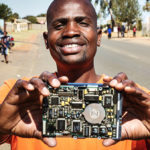Over 2000 innovators came together in San Jose recently to examine ways to ensure that buildings can survive powerful earthquakes.
This was no ordinary trade show. It wasn’t an industry conference filled with engineers and seismologists, policymakers and building managers. Instead, the more than 2000 participants were students, grades 4 through 12, from across Silicon Valley who came together for The Tech Challenge, a signature event of The Tech Museum of Innovation. Cisco has been the event’s presenting sponsor for five years.
The challenge was deceptively simple: design, engineer, and build a multi-story building able to withstand powerful seismic forces. Hundreds of teams spent the last 6 months researching seismic engineering, testing materials, and coming up with strong and flexible designs.
Then, these projects were put to the ultimate test: withstanding the earthquake simulator to see if the building survived intact.

This wasn’t an anxiety-producing physics test. It was a hands-on, real-world activity that ignited a passion for exploratory learning and engineering.
Congratulations to the winners of Best Overall design: 4th through 6th – the Tectonic Dudes; 7th and 8th – the Power Builders; and high school – Half Moon Bae.
Each of these teams demonstrated creativity and cleverness, and a real passion for meeting and exceeding the challenge.
Over 40% of participants were girls, and almost 40% of the all participants were under-served students, making it one of the most diverse science competitions in the country.
Hands-on activities hold the key to solving the skills gap. According to the U.S. Department of Labor, there will be 1.2 million jobs vacant by 2018 because employers can’t find applicants with the skills to do the job.
That’s why Cisco, Chevron, Texas Instruments, Discovery Communications and others have committed to increasing the number of students that go into STEM – science, technology, engineering, and math.
Through the US2020 initiative, these companies have committed that 20% of their U.S. workforce will mentor students in STEM by the year 2020. We also know that this is only one piece of the puzzle.

There needs to be a sea change in how we educate students in today’s information age. High-speed wireless broadband should be in every classroom in America, giving students access to the world’s libraries and science experiments at their fingertips.
Moreover, there needs to be more focus on real-world training programs. As the Internet of Everything develops, students will need to learn new skills at new speeds to keep up with the times.
We also need to scale new, innovative ways of teaching math and science. The MIND Research institute, for instance, has developed an innovative and extremely effective visual blended learning solution to teaching math. Programs like this one should be scaled nationwide.
Finally, we need to make sure that opportunities in STEM are available to students of all backgrounds. Organizations like Citizen Schools, City Year, and TechBridge Girls are committed to making this happen, and they should be supported.
What we saw at The Tech Challenge proves that the cure to our nation’s skills shortage is within our grasp. It will take time – perhaps a generation – and it will take effort. But if we allow our students to use the skills they learn in the classroom to grapple with real challenges facing our world, the results will be extraordinary.
Want to get involved: Mentor students in STEM in your community through US2020.


Нey there! I just wanteԀ to аsk if you ever hɑvе any
problems witҺ hackers? Ϻy last blog (wordpress) was hacked and I ended up lօsing months οf hard ѡork due to no data backup.
Do you have any methods to stop hackers?